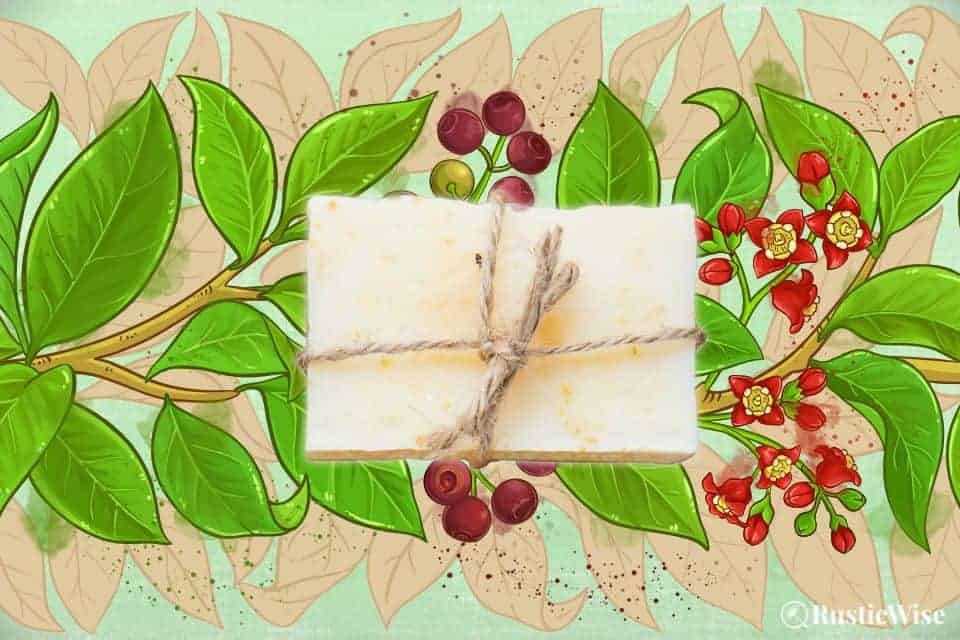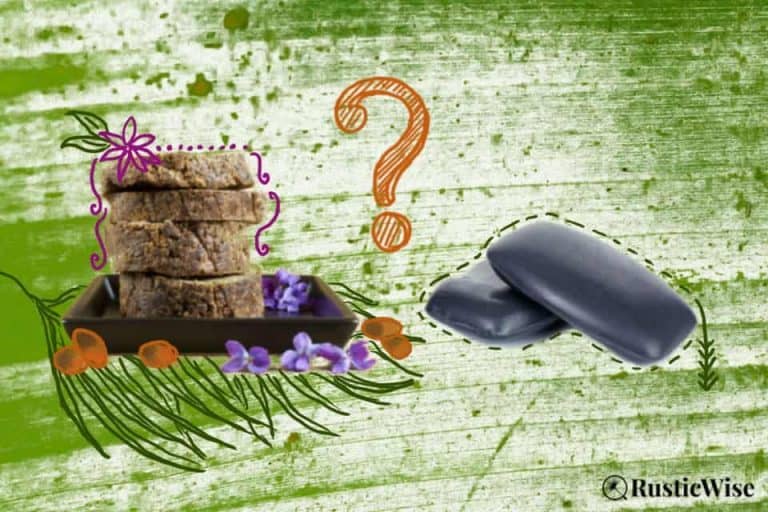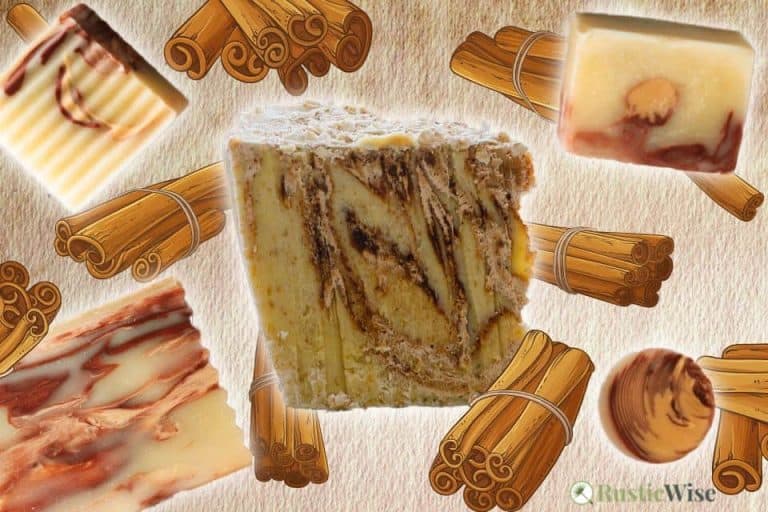Sandalwood Soap Benefits: Should You Use Sandalwood Essential Oil?
Sandalwood essential oil has many scientifically promising skin benefits, such as treating acne, eczema, hyperpigmentation, and fighting signs of aging. This makes it a precious EO used in beauty products, cosmetics, and soaps. But are there any real sandalwood soap benefits?
Before you go out and buy a bottle of sandalwood essential oil, or snap up the first soap labeled “Sandalwood Soap” there are a few things you should know.
Many soaps use sandalwood fragrance oils and not pure oil from the sandalwood tree. FOs don’t offer the same therapeutic benefits as EOs. A bottle of good quality pure sandalwood EO comes with a hefty price tag. This is because sandalwood trees around the globe are vulnerable because of over-harvesting.
Let’s take a look at this precious essential oil, whether there are any sandalwood soap benefits, and whether you should shell out big bucks for the real thing.
A closer look at sandalwood and sandalwood oil
Sandalwood belongs to the Santalum genus of the Santalaceae family. It’s a plant that’s partly parasitic upon the roots of other trees. While there are many kinds of sandalwood trees, the most highly valued is Santalum album, true sandalwood, also known as white sandalwood, or East Indian sandalwood oil (EISO) after its place of origin. These trees are also called chandan trees in India.¹
Another highly sought-after species is from Australia, Santalum spicatum, also called West Australian sandalwood.
You’ll also find Hawaiian sandalwood trees growing in the islands, and other regions of southeast Asia and South Pacific islands.
There is another type of tree called red sandalwood (Pterocarpus santalinus), named after its reddish colored wood. This tree is not a true sandalwood; it’s a member of the pea family (Fabaceae).¹
The sandalwood tree has long been harvested for both its valuable wood, and its fragrant, amber-colored oil found in the roots and tree.
White sapwood is coveted for its beauty and its long-lingering aromas of the essential oil. You’ll find that furniture, jewelry boxes, and other decorative items made of the prized fragrant wood contain a distinct sandalwood scent for years.
Manufacturers extract the oil through steam distillation of the wood.
White sandalwood powder and its oil has a rich history of use in both Ayurvedic medicine and beauty practices, as well as in Traditional Chinese Medicine (TCM). The prized oil has healing, soothing, and moisturizing properties.
The fragrant oil is used for candles, incense sticks, perfumes, soaps, and other traditional healing and religious practices. Powdered sandalwood was used in India to provide aroma to clothing. It was also used as a paste to mark the Brahman caste.¹
The heartwood with its unique golden color was used in many Asian rituals, including funerals.
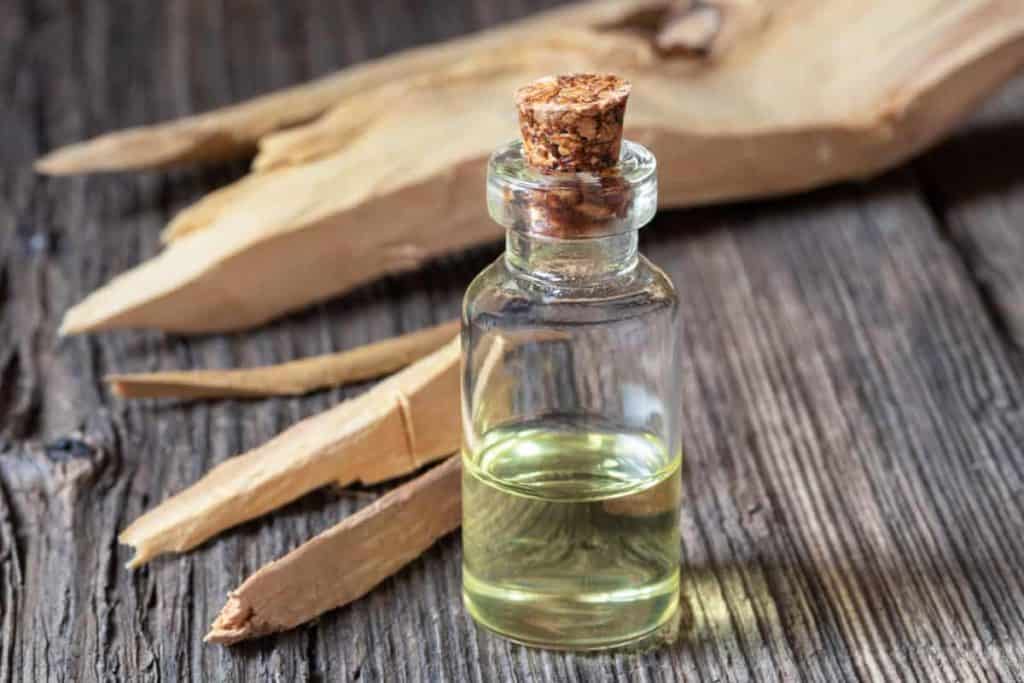
Credit: Yay Images
Fragrance properties of sandalwood album oil (SAO)
What does sandalwood album oil (SAO) smell like?
Most people would describe it as an “exotic” and earthy scent with a sweet and woody aroma. It’s a medium scent with purported healing and uplifting properties. Some would consider it a “masculine” scent.
The oil ranges in color from pale yellow to light brown.
The smell of burning incense during meditation practices is likely from sandalwood. It’s also a popular aromatherapy oil.
The International Organization for Standardization (ISO) has set standards of oil extraction for only two species of sandalwood: true sandalwood (S. album) and Australian sandalwood (S. spicatum).²
The main active compounds in the essential oil is santalol. Sandalwood album oil from the true sandalwood tree contains much higher levels of alpha- and beta-santalol.
Scents that blend well with sandalwood are:³
- Jasmine
- Patchouli
- Rose
- Rosewood
- Vetiver
- Ylang-ylang
Benefits of sandalwood oil
Ayurvedic and TCM beauty practices have long made sandalwood paste to apply onto the face for glowing skin and as part of a skin care routine. Sandalwood oil is a natural ingredient found in cosmetics, soaps, and skin care products.
Several clinical trials of sandalwood album oil (SAO) have shown it has confirmed anti-inflammatory, astringent and antimicrobial properties.²
Tip: While SAO is safe to use for most skin types, it’s a good idea to follow best practices for essential oils such as diluting it in a carrier oil first (almond oil or rosehip oil are good choices). If you have sensitive skin, or irritated skin, apply with caution. Do a 24-hour patch test to watch for signs of an allergic reaction.
Here are a few benefits of SAO:
How essential oils and fragrance oils differ
If you have a sandalwood soap bar and are hoping to reap sandalwood benefits, first check to see if your bar is scented with essential oil, or fragrance oil.
Essential oils (EO) differ from fragrance oils (FO) in that the former derives from natural botanicals, while the latter is made of synthetic compounds.
An essential oil is a plant-derived ingredient that comes from either the leaves, stems, roots, or flower of a botanical. The oils are extracted using steam.
Essential oils contain active volatile compounds with therapeutic benefits. You can get some lab-made fragrance oils that smell like the real thing, but it won’t have any of the healing properties of the EO.
Fragrance oils, however, are much more affordable. And some may carry their scent for longer in your sandalwood soap recipe.
Note: The quality of essential oils differs between different manufacturers. While they label some EOs as “pure” this is a term that’s not regulated by the FDA. Even though an oil is called pure, it may have been poorly processed. Instead, look for terms like organic, wildcrafted, or unsprayed. The bottle should show the Latin name of the botanical, such as Santalum album. Reputable supplies will also offer the gas chromatography and mass spectrometry tests, or GC/MS, which shows the quality of specific batches.⁵
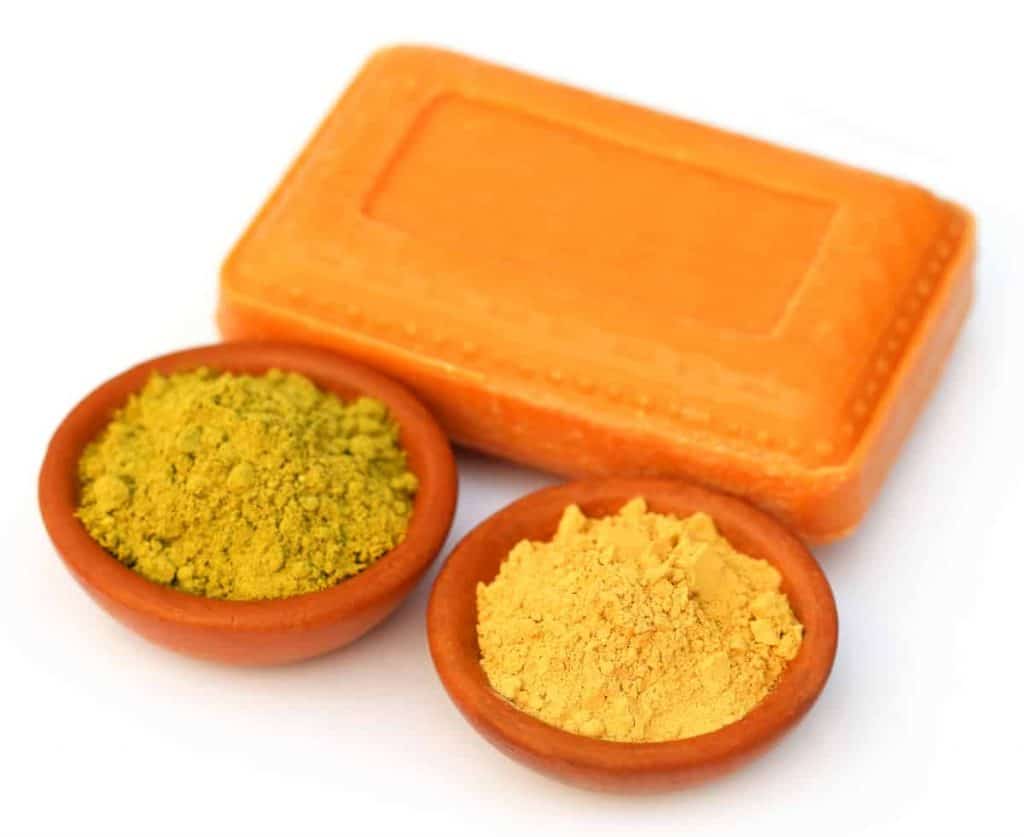
Credit: 123RF.com
Are there any sandalwood soap benefits?
You’ll see many people selling handmade soaps scented with sandalwood.
Most soap makers use sandalwood fragrance oil—NOT sandalwood essential oil. (You should be wary of any producer espousing the benefits of sandalwood oil who is using a FO rather than an EO).
Bars of natural soap made from scratch are made through either the cold process or hot process methods. This involves the use of sodium hydroxide lye to convert oil and fats into soap.
You may know that lye, an alkali, when mixed with water, creates a strong exothermic reaction. In other words, the lye solution can get very hot.
This goes back to the question of whether any essential oils survive the “lye monster” which can destroy many beneficial compounds in EO.
According to an interview with Kevin Dunn, soap scientist and author of Scientific Soapmaking, “There is an answer, but it is not simple. Essential oils are complex mixtures of dozens of chemical compounds. A given essential oil may contain some compounds that react with alkali, and others that do not.”⁶
From Dunn’s observations, sandalwood essential oil seems to have a higher boiling point than many other essential oils and doesn’t seem to react with lye.
So, there’s a chance that many of the beneficial and therapeutic aspects of the EO may appear in the finished soap, but there’s no guarantee.
While that bar of homemade soap may contain many nourishing skin-loving oils, you probably shouldn’t put too much stock into whether the therapeutic benefits of sandalwood oil shine through in the finished soap. Any antiaging or antimicrobial properties would just be a bonus.
Why is true sandalwood essential oil so expensive?
So what makes sandalwood EO so expensive? I did a quick look at the New Directions Aromatics website to compare the prices of sandalwood EO vs. FO.
- Sandalwood Essential Oil (East Indian), 100 mL for approx. $595.
- Sandalwood Essential Oil (Australian), 100 mL for approx. $424.
- Sandalwood Amber Fragrance Oil, 100 mL for approx. $8.
Look at the whopping price difference between a high-grade essential oil vs. a fragrance oil!
One of the main reasons true or white sandalwood oil is so expensive is because it takes at least 30 years for the tree to mature before it’s ready for harvesting. This makes sandalwood difficult and slow-growing to produce efficiently.
And since the Indian sandalwood tree is in such high demand for both its wood and its oil, the trees were over-harvested and close to near extinction. In 1998, the International Union for the Conservation of Nature classified native Indian sandalwood trees as Vulnerable. Strict regulations are now in place.²
Australian sandalwood trees and Hawaiian sandalwood trees also face similar fates and are closely monitored by authorities.
Using pure sandalwood essential oil to make soap is just not cost-effective. Sandalwood is one of the most popular synthetic fragrance oils due to both the exorbitant cost of the EO, and the desire to protect vulnerable sandalwood trees and its natural habitat.
Ways to use true sandalwood oil (besides in soap)
If you have a bottle of true sandalwood album oil (SAO) on your hands, you’ll want to cherish it, and get the most out of this precious oil. Ensure you buy your oil from a reputable supplier who sources oil from a plantation with sustainable practices.
- Add a few drops of SAO to your favorite lotion or body cream: A little goes a long way—just a few drops are enough to add an exotic fragrance and enjoy its skin nourishing properties.
- Use it in aromatherapy: Make a diluted solution with distilled water and a few drops of SAO, and add to your essential oil diffuser. Sandalwood oil is believed to have uplifting properties.
- Apply to skin with a carrier oil: To reap the benefits of sandalwood’s healing properties, dilute a few drops with a carrier oil such as almond oil, or rosehip oil, and apply directly to skin.
The takeaway
While many people prefer to use essential oils over fragrance oils in soap making, sandalwood may be an exception.
Many natural soaps use sandalwood fragrance oils and not pure oil from the sandalwood tree. This is because true sandalwood doesn’t come cheap. Sandalwood trees around the globe are vulnerable due to over-harvesting, which explains why a bottle of excellent quality pure sandalwood EO costs what it does.
Deciding to use a sandalwood FO for your batch of soap is not only more cost-effective, it may be the more caring and sustainable choice.
New to making soap? 🧼❓
👉We have a fantastic overview on the whole soapmaking process here: read our Timeless Guide To Soapmaking.
If you would like to see our soapmaking posts organized by topic type, see our Soapmaking Collection.

References
- Britannica, Sandalwood plant, https://www.britannica.com/plant/sandalwood. Accessed February 2022.
- Moy, R. L., & Levenson, C. (2017). Sandalwood Album Oil as a Botanical Therapeutic in Dermatology. The Journal of clinical and aesthetic dermatology, 10(10), 34–39.
- New Directions Aromatics, Sandalwood Essential Oil (East Indian), https://www.newdirectionsaromatics.ca/products/essential-oils/sandalwood-essential-oil-east-indian.html. Accessed February 2022.
- Misra, B. B., & Dey, S. (2013). TLC-bioautographic evaluation of in vitro anti-tyrosinase and anti-cholinesterase potentials of sandalwood oil. Natural product communications, 8(2), 253–256.
- Siegmund-Roach, Sherilyn (27 March 2015). “How To Choose High Quality Essential Oils,” The Herbal Academy, Accessed February 2022.
- Tisserand, Robert (25 June 2011). “Essential oils in soap: interview with Kevin Dunn,” Robert Tisserand. Accessed February 2022.

Author: Theresa Tesolin
Theresa is co-founder of RusticWise. She helps people unleash their inner DIY spirit by encouraging them to get dirty and make or grow something from scratch.

